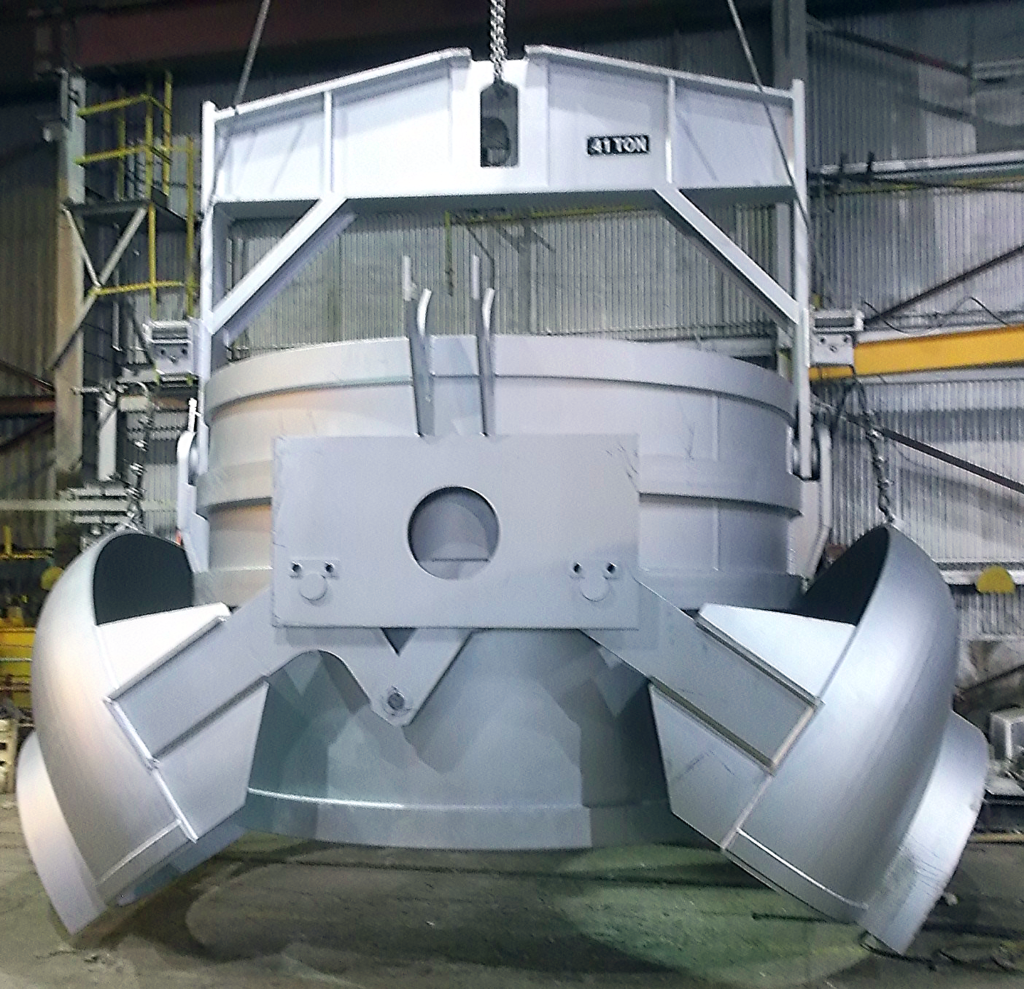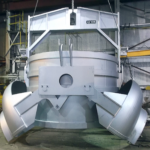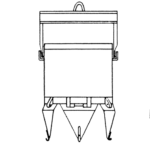charge buckets
Our Charge buckets Solutions


Drop-Bottom Charge Bucket
With a “drop-bottom” charge bucket, the top-charge furnace can be completely charged in a few minutes. The bucket may be loaded while the furnace is in operation, with the charge arranged in the bucket precisely as you desire it placed in the furnace.
Buckets are designed to require minimum headroom and can hold a volume equal to the volume of the furnace to be charged. Thus’ one bucket can completely fill the furnace.
The back charging operation is sometimes used to increase the charge of molten metal above the rated capacity of the furnace, for especially large heats. Or back charging may be resorted to when especially light scrap is used and the initial charge does not produce the tonnage required for the heat. After the original charge has partially melted, there is room in the furnace for a second charge – a back charge.
Clamshell Type Charge Bucket
The Clamshell type charge bucket is the most common used charge bucket for charging the top charge Electric Arc Furnace. The Whiting Clamshell charge bucket is loaded with scrap steel on the ground.
Once it is loaded the crane operator will hoist the charge bucket up with the main hook and position the charge bucket directly above the top charge electric arc furnace. The Whiting Clamshell charge bucket uses the cranes auxiliary hook to pull on wire rope cables to open the bottom of the charge bucket. The charge is now in the electric arc furnace shell and the clamshells return to their closed position. The clamshells have a flat surface on the bottom to allow the charge bucket to sit safely on the ground when not in use or while the scrap steel is loaded.
Orange Peel Type Charge Bucket
Different mechanisms are employed to hold and release the orange-peel segments-the oldest, perhaps, being a rope tied around a hook on each segment.
When the heat of the furnace burns through the rope, the segments are released; opening the bucket, and allowing the charge to fall into the furnace. (If the furnace is cold, a torch is applied to the rope through the furnace door.) The ease with which the rope-tie bucket is closed makes it very popular. As the open bucket is lowered into a bottom-closing stand, the dished head receives the segments and closes them as the bucket is lowered. The central section of the dished head is cut out, exposing the rope hooks for convenient tying. The rope is passed once or twice around the six hooks and securely knotted, completing the operation. The Whiting Rope – Tie Bucket is sturdily built to withstand the mechanical shocks of charging and to withstand furnace heat. The design of the segments prevents damage to refractory walls when the charge is released … the rope hooks being well shielded behind the contour of the bottom, preventing the hooks from damaging refractory walls or arches. Whiting Rope – Tie Buckets may be furnished with lifting stirrups, bail, or yoke-depending upon individual requirements. The yoke is recommended where crane clearances are limited.
Whiting Sivyer – Mechanically Activated Latch System
The Whiting-Sivyer Charge Bucket was developed to overcome some of the inherent problems of rope-tie buckets, and provide greater safety. How securely a rope-tie bucket holds its charge depends entirely on the strength of the rope and how well it is tied. If the rope is strong, furnace-time and heat may be lost waiting for the rope to burn through.
If the rope is weak or insecurely tied, there is danger that the charge may be dropped before it reaches the furnace-which would be hazardous as well as expensive. Thus at best, the rope-tie bucket represents a compromise between safety and production. The cost of rope is also an item. The Whiting-Sivyer Bucket has a special mechanism which automatically releases the charge into the furnace when the bucket reaches the proper position. A safety pin, which prevents accidental opening of the bucket, is removed when the bucket is over the furnace … then the bucket is lowered until a trip bar touches the furnace bottom and opens the orange-peel segments. The bucket is lifted out and the furnace is put in operation immediately thus holding charging time to an absolute minimum. The bottom segments of Whiting-Sivyer Buckets are closed in sequence by lowering the bucket to a horizontal position on offset trunnions. Gravity closes the upper two segments, the lower two are raised, those at the sides are swung into position and the safety pin is set thus making the bucket ready for recharging for the next heat. To use the Whiting-Sivyer Bucket for back-charging, the trip bar is extended around to the side of the bucket so that it may be tripped manually. The Whiting-Sivyer Bucket is sturdily built to withstand mechanical shocks, as well as furnace heat during top-charging operations. The bottom segments are steel castings. The bucket may be supplied with lifting stirrups, bail or yoke, depending upon shop requirements.



